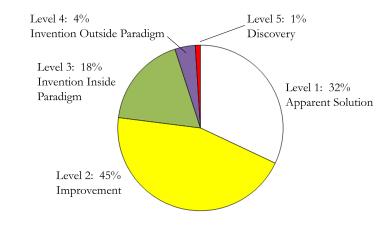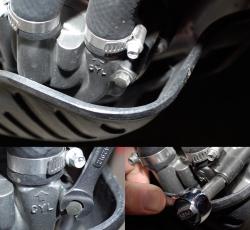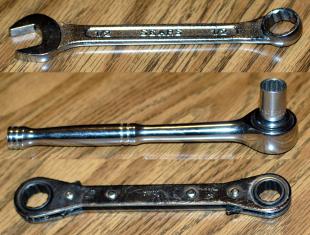Excerpt from the Book
Unleashing Engineering Creativity
By Joe Berk, Principal Member, Eogogics Engineering Faculty
This lavishly illustrated book, also sold separately, is the textbook component of the Eogogics “Unleashing Engineering Creativity” workshop that is available for presentation worldwide.
The course includes real world examples, interesting case studies, and stimulating exercises to ensure that the participants thoroughly understand the advanced creativity techniques and can apply them on the job. Here’s a sample chapter on the TRIZ technique.
Take a FREE Web class to learn TRIZ (real class, not a sales webinar). It’s FREE, so sign up now!
TRIZ
TRIZ is an acronym for teoriza rezhinija izobretatalskih zadach. These Russian words translate into the theory of inventive problem solving.
As the words imply, the technique came to us from the former Soviet Union. We learned about TRIZ during the perestroika period when the Soviet Union opened up to the western world. Prior to that time, TRIZ had been a confined to the Soviet Union.
The TRIZ technique was developed by Genrich Altshuller, who lived from 1926 to 1998. His story is an interesting one. Altshuller was a Russian navy officer who worked in their Soviet patent office. After processing literally tens of thousands of patents and patent applications, patterns started to emerge.
Altshuller made two observations:
- Very few innovations contained in the patent applications were truly new concepts.
- The innovations the patent applications contained followed common patterns.
Altshuller found that nearly all of the patent applications were actually slight modifications of the engineering concepts contained in prior patents. The industries and products were different, but the underlying approaches had common themes.
After World War II and during Stalin’s era, stating such a position (which could be interpreted that the Soviets were not very creative) was not politically correct. Stalin and the existing Soviet power structure did not like hearing that its inventions were simply copies using the principles outlined in earlier inventions. Altshuller was sent to prison, where he remained from 1950 to 1954.
Ultimately, rational thought prevailed and the Russians recognized the value of Altshuller’s ideas. Instead of viewing Altshuller as a threat, the Soviets came to realize that his work could be used as a catalyst for accelerating the creative process. They released Altshuller and he continued to develop a concept that ultimately became known as TRIZ.
After reviewing approximately 40,000 patents, Altshuller reached the following conclusions:
- Inventions and innovations followed common patterns. These common patterns cut across industry and technology boundaries.
- Innovation is a process, and as such, it can be taught.
- Inventions can be grouped into levels, ranging from simply adapting existing concepts (a relatively common and easy practice) to completely new discoveries and applications of these new discoveries (a relatively rare practice).
Altshuller’s formalization of the TRIZ process was hugely successful in the Soviet Union. As the Soviet Union opened to the rest of the world, TRIZ gained recognition and acceptance in other countries. TRIZ has been widely studied by western cultures. The technique figures prominently in Six Sigma and other modern product and process improvement technologies.
Levels of Invention
Altshuller categorized inventions into five levels. The levels start with inventions that are obvious, and extend through several gradations to those that require and utilize completely new discoveries. Altshuller’s five levels are:
- Level 1: Apparent Solution. This invention level requires no real invention; it consists of minor adaptations of existing concepts. Surprisingly, Altshuller found that fully 32 percent of all patent applications were in this category.
- Level 2: Improvement. This category makes small improvements to existing approaches. Altshuller found this to be the largest category, comprising about 45 percent of all patent applications.
- Level 3: Invention Inside the Paradigm. This invention level uses methods from other fields, but significantly improves previous approaches. As might be anticipated, Altshuller found that the number of inventions in this category was larger than either Level 4 or Level 5. About 18 percent of all patent applications were in this category.
- Level 4. Invention Outside the Paradigm. This invention level involves a new design that is based on modifications of existing principles but in a manner not previously used. These are also relatively rare. Altshuller found that only about 4 percent of the patents he reviewed were in this category.
- Level 5: Discovery. This is the highest invention level. It consists of completely new concepts using new principles. Interestingly, Altshuller found that less than 1 percent of all the patent applications he reviewed were Level 5 inventions. Most inventions are not completely new things; they are adaptations of earlier ideas.
So what does all of the above mean? We don’t need to memorize the above, nor do we need to identify invention levels when we apply TRIZ concepts. We simply need to recognize the beauty of Altshuller’s observation, which was simply this: Not much is new in the world of inventions. We might view this as a negative or cynical observation, but it is not intended to be. It simply states the obvious. We don’t have to create completely new concepts based on completely new principles to create new designs.
We can recognize this and use Altshuller’s findings as a tool to guide us in creating new inventions.

Figure 1. Altshuller’s Levels of Invention. Very few patent applications represented truly new concepts; most were modifications or adaptations of earlier ideas.
Perhaps one of the best examples of the above concept predates Altshuller’s observations about very little being new in the world of inventions. Paul Mauser’s invention of the bolt action rifle in the late 1800s was inspired by the bolt on a simple gate latch. Figure 2 makes this very obvious.
Figure 2. Bolt Mechanisms On Gate Latch and Mauser Rifle. A simple gate lock mechanism inspired the bolt action rifle.
Using TRIZ
Altshuller’s theory of inventive problem solving is simple. It recognizes that all design challenges contain contradictions. The contradictions are grouped into two categories:
- Technical Contradictions. Technical contradictions involve compromises between competing parameters. For example, if we want to increase strength, we have to also increase weight. If we want to increase capacity, we have to increase size. In other words, an improvement in one parameter involves degradation in another.
- Physical Contradictions. Physical contradictions involve time or space, where a product must do different things depending on the condition or the time in which it must perform its functions. We might have a condition where two objects need to occupy the same space, or a product needs to perform different functions under different conditions. You might think of a street intersection. Cars need to move across the same intersection, but if they attempt to do so at the same time, they will collide. Or, you might think of a screwdriver that needs to reach a relatively inaccessible screw. The screw driver shaft has to be flexible to reach the screw, but it needs to be rigid to transmit torque to the screw.
TRIZ recognizes that these two different categories (technical and physical) exist, and it offers two different approaches for creatively inventing solutions. The easiest creative challenges to address are the physical ones, so we’ll discuss those first.
Resolving Physical Contradictions
Physical contradictions usually involve situations in which the contradiction must be present and absent. The solution to such situations typically involves separation.
Figure 3. Chicago’s Elevated Railway Over Street Intersection. This solution resolves physical contradictions through separation in space (the elevated railway) and time (the traffic lights).
We can separate the contradiction in time, we can separate the contradiction in space, we can separate the contradiction based on conditions, or we can separate the contradiction based on separating the components from the whole assembly. Sometimes we resolve the contradiction through combinations of these approaches to separation. These concepts are admittedly abstract. They become easier to understand by considering several examples.
- Epoxy. Consider a two-part epoxy mix. The epoxy has to be both liquid and solid. It is kept in liquid form prior to use so that it can flow and be mixed. After mixing, it solidifies and forms a powerful bond and seal. The physical contradiction is that it must be both liquid and solid, but we solve the problem by separating the two parts in space and by separating the components from the whole. As long as the two epoxy parts are kept separate, they are liquid. Once they are no longer kept separate (when they are mixed), they become a solid.
- Aircraft Controls. On modern high performance combat aircraft, weight is a major design consideration. Aircraft designers keep the weight low through many design practices, including dual uses for many of the cockpit controls. Switches perform different functions depending on aircraft mode. On the F-16 Air Combat Fighter, for example, the trigger serves to fire the onboard 20mm cannon when the aircraft is in the gun mode, the missiles when it is in the missile mode, and the camera when it is in the camera mode. The trigger functions are separated in time and by condition, allowing the trigger to overcome a physical contradiction.
- Drive Chains. Consider the bicycle chain. It must be both flexible to wrap around the sprockets and move from sprocket to sprocket as the rider changes gears, and rigid to transmit pedal inputs to the rear wheel. The chain accomplishes this by separating the components from the whole. Each chain link is rigid. When the links are combined into a chain, the chain becomes both flexible and rigid. The contradiction (the requirement for flexibility and rigidity) is solved by separating the components from the whole.
- Traffic Intersections. Cars have to cross intersecting streets and highways without crashing into each other. Some intersections use traffic lights or stop signs to separate the cars in time. Other intersections use overpasses to eliminate the contradiction by separating the cars in space (see Figure 3).
This is good stuff. Note in the above examples that the applications and creative challenges are dramatically different, but in many cases the principles (separation in time, separation in space, separation by condition, or separation of the component from the whole) are the same. The TRIZ message here is simple: When faced with a physical contradiction, look to these four separation approaches (or combinations of the above) to meet the challenge.
Resolving Technical Contradictions
The approach for resolving technical contradictions involves use of Altshuller’s problem solving principles along with another tool he developed: The contradiction matrix. The contradiction matrix is an elegant approach for resolving technical contradictions.
Based on his patent review, Altshuller recognized 40 problem-solving principles. These are:
- Segmentation
- Separation (extraction)
- Local characteristics
- Symmetry
- Merging
- Multifunctionality
- Nested doll
- Weight compensation
- Preliminary counteraction
- Preliminary action
- Beforehand compensation
- Equipotentiality
- “The other way around”
- Curvature increase
- Dynamic parts
- Partial or excessive action
- Dimensonality change
- Mechanical vibration
- Periodic action
- Continuity of useful action
- Hurrying
- “Blessing in disguise”
- Feedback
- Intermediary
- Self-service
- Copying
- Cheap disposables
- Mechanical interaction substitution
- Pneumatics and hydraulics
- Flexible shells and thin films
- Porous materials
- Optical property changes
- Homogeneity
- Discarding and recovering
- Transformation of properties
- Phase transitions
- Thermal expansion
- Accelerated oxidation
- Inert atmosphere
- Composite materials
Altshuller categorized the above 40 principles into 11 groups:
- Segmentation, separation (Principles 1 and 2).
- Local characteristics, symmetry, merging, multifunctionality (Principles 3 to 6).
- Preliminary counteraction, preliminary action, beforehand compensation (Principles 9 to 11).
- Equipotentiality, “the other way around,” curvature increase (Principles 12 to 14).
- Dynamic parts, partial or excessive action, dimensionality change, mechanical vibration (Principles 15 to 18).
- Periodic action, continuity of useful action, hurrying (Principles 19 to 21).
- “Blessing in disguise,” feedback, intermediary (Principles 22 to 24).
- Self-service, copying, cheap disposables, mechanical interaction substitution (Principles 25 to 28).
- Pneumatics and hydraulics, flexible shells and thin films, porous materials (Principles 29 to 31).
- Optical property changes, homogeneity, discarding and recovering (Principles 32 to 34).
- Transformation of properties, phase transitions, thermal expansion (Principles 35 to 37).
- Accelerated oxidation, inert atmosphere, composite materials (Principles 38 to 40)
The groups listed above are logical clusters of the 40 problem-solving principles. We’ll see how they are used below.
To resolve technical contradictions, we first have to recognize and describe the contradiction. Knowing what the contradiction is allows us to consider approaches for resolving it. Unlike most design approaches in which resolving the contradiction usually involves compromises among the factors in conflict, TRIZ offers approaches for doing so without compromising either of the items in contradiction. We can do this by considering the resources or properties available to us that are inherent to the system, and by using Altshuller’s contradiction matrix.
The contradiction matrix is perhaps the greatest TRIZ tool for stimulating our creativity. The contradiction matrix is a 39 x 39 matrix. The matrix rows list parameters we want to change, and the columns are conflicting parameters. The rows and columns list the same items; we just need to find pairings that are in conflict by identifying one parameter in a row and the other in a column (or vice versa).
At the intersection of the rows and columns (the cells inside the 39 x 39 matrix), Altshuller lists which of the 40 inventive principles listed above have been used on prior inventions to break the conflict.
The above sounds simple, and after you’ve used it a bit, it is. There’s a learning curve, though, and it takes some practice to become adept at using the technique. There’s some art in identifying the inherent conflict, and then deciding which of the 39 row or column descriptors best fit your conflicting parameters. If the contradiction matrix doesn’t provide insights to you in resolving the conflict, you can try applying different selections from the contradiction matrix rows and columns that might be applicable to the parameters for which you are attempting to resolve a conflict.
Let’s consider an example. Suppose we have a situation with a relatively inaccessible bolt head as shown in Figure 4 and we need to shorten the amount of time it takes to remove the bolt.
There are two approaches to consider:
- We can use a standard wrench. This will work because the wrench’s narrow width provides access to the bolt head, but it is slow. We have to remove the wrench from the bolt head and re-index it repeatedly to remove the bolt.
- We would like to be able to use a ratchet with a socket because it is much faster, but the socket and ratchet combination are too big to work with the bolt head’s limited access.

Figure 4. Limited Access Bolt Head. The head is accessible with a box end wrench, but not with a ratchet, making it slow to remove. We would like to have a tool that fits into the limited access area and provides rapid removal.
We have a contradiction here. We want to use the faster tool, but the bolt head’s accessibility mandates use of the slower tool. The questions we face in applying TRIZ to this situation are:
- What categories in the contradiction rows and columns are applicable?
- When we consider the intersection of the rows and columns in the contradiction matrix, which of the 40 inventive principles are applicable?
Sometimes the contradiction matrix won’t have anything in the row and column intersection. When this situation is encountered, it means either that the TRIZ approach won’t work or we need to find a different descriptor in either the row or the column.
At other times, the contradiction matrix will list more than one inventive principle in the intersection cell. When this occurs, we need to think through the inventive principles and select the ones that are potentially applicable.
For a complete listing of the TRIZ contradiction matrix, take a look at http://www.triz40.com/aff_Matrix.htm (the matrix is too big to appear in full here). You can see that it lists the same parameters along the top to identify the matrix columns (here they are labeled as “worsening features”) and the left side to define the rows (they are labeled as “improving features”).
In our example, we’ll opt for Parameter 4 along the top of the contradiction matrix (“length of stationary object”) and Parameter 25 along the right side of the contradiction matrix (“loss of time”). Parameter 25 is very closely aligned with our situation, but Parameter 4 is just a bit of a stretch. It appears to be the closest one related to size, though, so that’s why we selected it in this example.
If we read down the Parameter 4 column until it intersects with the Parameter 25 row (see Figure 5, which is excerpted from the contradiction matrix), we see four inventive principles listed where the row and column intersect:
5. Merging
14. Curvature increase
24. Intermediary
30. Flexible shells and thin film

Figure 5. Contradiction Matrix Excerpt. The contradiction matrix suggests examining four inventive principles for the wrench problem.
Not all of the inventive principles listed in the intersection will offer solutions, and as mentioned earlier, there is some art in applying the contradiction matrix. Experience in using the technique helps, and the best way to gain this experience is to start using the approach.
In this application, it is difficult to envision how using a curvature increase, an intermediary component or subassembly, or flexible shells and a thin film would help to provide a solution for rapidly removing a bolt with limited access to the bolt head. But what about Inventive Principle 5, or merging? Might that offer a potential solution?
Figure 6. Box End, Ratchet, and Ratcheting Box End Wrenches. The ratcheting box end wrench is the result of applying Inventive Principle 5, or merging.
If we ponder this for a bit, merging does indeed offer a potential solution. If we merge the concepts inherent in a standard wrench and a ratchet and socket, we have the ratcheting box end wrench (see Figure 6).
The application works well, as Figure 7 shows.
Figure 7. Ratcheting Box End Wrench. This tool provides rapid removal and installation with limited bolt head access.
Summary
Very few innovations are truly new concepts. We can take advantage of this fact when faced with creativity challenges by using TRIZ, the theory of inventive problem solving. TRIZ recognizes that all inventive problems involve either technical or physical contradictions. Physical contradictions can usually be addressed separation either in time or in space. Technical contradictions can usually be addressed through the use of the contradiction matrix. Once we’ve identified the contradictions, the contradiction matrix will suggest which of the 40 inventive principles offers potential solutions.
Activity
Suppose you wish to develop a printer capable of printing a standard 8½ x 11 page, and the printer can be no larger than a smart phone.
What are the contradictions inherent to this creative challenge?
What does the contradiction matrix suggest as potential inventive principles to consider in meeting this creative challenge?
Editor’s Note: The lavishly illustrated, Unleashing Engineering Creativity book (excerpted above) is a textbook component of the Eogogics workshop called Unleashing Engineering Creativity that’s available for presentation worldwide. (The book can also be purchased separately.) The course includes real world examples, interesting case studies, and stimulating exercises to ensure that the participants thoroughly understand the advanced creativity techniques and can apply them on the job. For more on the book or the workshop, please visit www.eogogics.com/create

